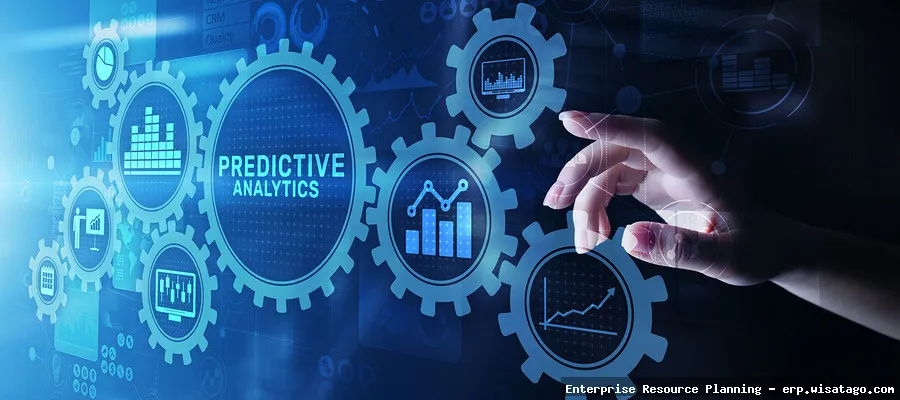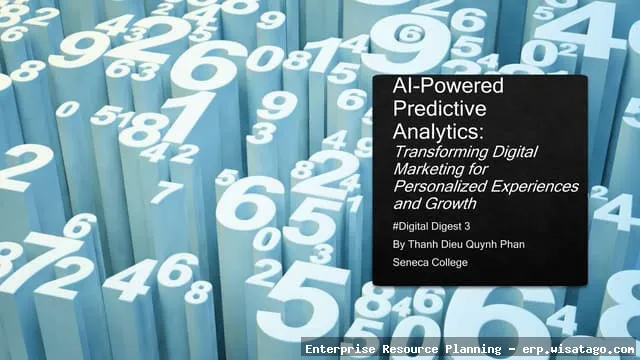AI-Powered Predictive Analytics In ERP Platforms: Complete Guide, Features and Details
Imagine running a business where you could predict future demand with pinpoint accuracy, optimize your inventory levels to avoid stockouts and overstocking, and proactively identify potential supply chain disruptions before they even occur. That’s the promise of AI-powered predictive analytics in Enterprise Resource Planning (ERP) platforms. For years, ERP systems have been the backbone of countless organizations, centralizing data and streamlining operations. But now, with the integration of Artificial Intelligence (AI), these systems are evolving into powerful predictive engines, offering a level of insight and foresight previously unimaginable.
As someone who’s been deeply involved in ERP implementations and optimization for a variety of businesses, I’ve seen firsthand the transformative impact of integrating AI-driven predictive analytics. We’re talking about moving beyond simply reacting to past performance and instead, actively shaping the future. This isn’t just a technological upgrade; it’s a fundamental shift in how businesses operate, enabling them to make data-driven decisions with confidence and agility. It’s about turning your ERP from a system of record into a strategic asset.

In this comprehensive guide, we’ll delve into the world of AI-powered predictive analytics in ERP platforms. We’ll explore what it is, how it works, its key features, real-world applications, and the benefits it can bring to your organization. Whether you’re a seasoned ERP user or just starting to explore the possibilities, this article will provide you with the knowledge and insights you need to understand and leverage the power of predictive analytics to drive business success. We’ll also touch upon the challenges involved and offer guidance on choosing the right solution for your specific needs.
Understanding AI-Powered Predictive Analytics in ERP
At its core, AI-powered predictive analytics in ERP involves using artificial intelligence algorithms, particularly machine learning, to analyze historical and real-time data within the ERP system. This data can include sales figures, inventory levels, customer behavior, market trends, and even external factors like weather patterns or economic indicators. By identifying patterns and correlations in this data, the AI algorithms can then forecast future outcomes with a high degree of accuracy. This allows businesses to make proactive decisions that optimize operations, reduce costs, and improve profitability.
How it Works: The Key Components
The process typically involves these key steps:
- Data Collection and Integration: The ERP system acts as the central repository for data from various departments, including finance, sales, manufacturing, and supply chain. AI algorithms need access to this comprehensive dataset.
- Data Preprocessing: The raw data is often messy and incomplete. This step involves cleaning, transforming, and preparing the data for analysis. This includes handling missing values, removing outliers, and converting data into a suitable format.
- Algorithm Selection and Training: Different AI algorithms are suited for different types of prediction problems. Selecting the right algorithm and training it on historical data is crucial for accuracy. Common algorithms used include regression analysis, time series forecasting, and classification models.
- Model Validation and Testing: Once the model is trained, it needs to be validated using a separate dataset to ensure its accuracy and reliability. This involves comparing the model’s predictions to actual outcomes and making adjustments as needed.
- Deployment and Monitoring: The trained model is deployed within the ERP system, where it can continuously analyze data and generate predictions. Ongoing monitoring is essential to ensure the model’s performance remains accurate and relevant over time.
Key Features of AI-Powered Predictive Analytics in ERP Platforms
The specific features offered by AI-powered predictive analytics solutions in ERP platforms can vary, but some common and highly valuable features include:
Demand Forecasting
This is perhaps the most widely used application. AI algorithms analyze historical sales data, market trends, and other relevant factors to predict future demand for specific products or services. This enables businesses to optimize inventory levels, plan production schedules, and avoid stockouts or overstocking, leading to significant cost savings and improved customer satisfaction.
Inventory Optimization
Going beyond simple demand forecasting, inventory optimization uses AI to determine the optimal levels of inventory to hold at different locations and at different times. This takes into account factors like lead times, storage costs, and the risk of obsolescence. The goal is to minimize inventory holding costs while ensuring that products are always available when needed.
Predictive Maintenance
For manufacturing companies, predictive maintenance can be a game-changer. AI algorithms analyze data from sensors and other sources to predict when equipment is likely to fail. This allows businesses to schedule maintenance proactively, minimizing downtime and extending the lifespan of their assets. This reduces unexpected repair costs and improves overall operational efficiency.
Supply Chain Optimization
AI can analyze data from various sources to identify potential disruptions in the supply chain, such as delays in shipments, shortages of raw materials, or changes in supplier pricing. This allows businesses to take proactive measures to mitigate these risks, such as diversifying suppliers or adjusting production schedules. This enhances supply chain resilience and reduces the impact of unforeseen events.
Customer Churn Prediction
By analyzing customer data, AI can identify customers who are at risk of churning. This allows businesses to take proactive steps to retain these customers, such as offering personalized promotions or providing improved customer service. Reducing customer churn can have a significant impact on revenue and profitability.
Fraud Detection
AI can analyze financial data to identify fraudulent transactions or activities. This can help businesses prevent financial losses and protect their reputation. This is particularly important for industries like banking and e-commerce.

Real-World Applications and Benefits
The benefits of implementing AI-powered predictive analytics in ERP extend far beyond simply improving forecasting accuracy. Here are some specific examples of how businesses are using it and the results they are achieving:
Reduced Inventory Costs
A major retailer implemented AI-powered inventory optimization and reduced their inventory holding costs by 15% while simultaneously improving product availability. This was achieved by more accurately predicting demand and optimizing inventory levels across their network of stores.
Improved Production Efficiency
A manufacturing company used predictive maintenance to reduce unplanned downtime by 20%. This resulted in significant cost savings and improved overall production efficiency. They were able to anticipate equipment failures and schedule maintenance proactively, avoiding costly disruptions. Many organizations are now exploring digital transformation, ERP becoming a key consideration for streamlining operations
.
Increased Sales Revenue
An e-commerce company used customer churn prediction to identify at-risk customers and offer them personalized promotions. This resulted in a 10% increase in sales revenue and improved customer retention rates. By proactively addressing customer concerns, they were able to retain valuable customers and boost sales.
Enhanced Supply Chain Resilience
A global logistics company used AI to analyze supply chain data and identify potential disruptions. This allowed them to proactively reroute shipments and mitigate the impact of unforeseen events, ensuring that goods were delivered on time and in full. This improved customer satisfaction and reduced the risk of supply chain disruptions.
Challenges and Considerations
While the potential benefits of AI-powered predictive analytics in ERP are significant, it’s important to be aware of the challenges involved in implementing and using these solutions:
Data Quality
AI algorithms are only as good as the data they are trained on. If the data is incomplete, inaccurate, or inconsistent, the predictions will be unreliable. Ensuring data quality is crucial for success.
Integration Complexity
Integrating AI-powered predictive analytics solutions with existing ERP systems can be complex and time-consuming. It requires careful planning and execution to ensure that the systems work together seamlessly.
Skills Gap
Implementing and managing AI-powered predictive analytics solutions requires specialized skills in data science, machine learning, and ERP systems. Finding and retaining qualified personnel can be a challenge.
Cost
Implementing AI-powered predictive analytics solutions can be expensive, particularly for smaller businesses. It’s important to carefully evaluate the costs and benefits before making a decision.

Choosing the Right Solution
Selecting the right AI-powered predictive analytics solution for your ERP system is a critical decision. Here are some key factors to consider:
Business Needs
What are your specific business needs and goals? What problems are you trying to solve with predictive analytics? Understanding your specific needs will help you narrow down your options.
ERP Compatibility
Is the solution compatible with your existing ERP system? Does it integrate seamlessly with your data and processes?
Ease of Use
Is the solution easy to use and understand? Can your employees easily access and interpret the predictions?
Scalability
Can the solution scale to meet your growing business needs? Can it handle increasing volumes of data and more complex prediction problems?
Vendor Reputation
Does the vendor have a good reputation in the industry? Do they have a track record of successful implementations?
Cost
What is the total cost of ownership, including software licenses, implementation services, and ongoing maintenance?
Conclusion
AI-powered predictive analytics is transforming ERP systems from simple data repositories into powerful predictive engines. By leveraging the power of AI, businesses can gain valuable insights into their operations, optimize their processes, and make better decisions. While there are challenges involved in implementing and using these solutions, the potential benefits are significant. By carefully evaluating your business needs and choosing the right solution, you can unlock the power of predictive analytics and drive business success.
The future of ERP is undoubtedly intertwined with AI. As AI technology continues to evolve, we can expect to see even more sophisticated and powerful predictive analytics solutions emerge, further revolutionizing the way businesses operate and compete. Embracing this technology is no longer a luxury, but a necessity for businesses looking to thrive in today’s increasingly competitive landscape.
My advice? Start small. Identify a specific area where predictive analytics can have a significant impact and pilot a solution. Learn from the experience, refine your approach, and then gradually expand your implementation. With careful planning and execution, you can unlock the full potential of AI-powered predictive analytics and transform your ERP system into a strategic asset that drives sustainable growth and profitability.

Conclusion
In conclusion, the integration of AI-powered predictive analytics into ERP platforms represents a significant leap forward for businesses striving for operational excellence. This article has explored how this synergy empowers organizations to move beyond reactive decision-making, enabling proactive identification of potential challenges and opportunities across various business functions. From optimizing inventory management and predicting equipment failures to enhancing sales forecasting and improving customer retention, the benefits of leveraging AI within the ERP ecosystem are undeniable. Ultimately, AI-powered predictive analytics transforms ERP systems from tools of record-keeping into powerful engines of strategic foresight.
The journey toward embracing AI in ERP is not without its considerations, requiring careful planning, data quality management, and a commitment to continuous learning. However, the potential rewards – increased efficiency, reduced costs, and a significant competitive advantage – make it a worthwhile endeavor. As AI technology continues to evolve, its role within ERP platforms will only become more prominent. If you’re ready to unlock the full potential of your ERP system and gain a data-driven edge, explore the possibilities of AI-powered predictive analytics. Consider researching leading ERP vendors offering integrated AI solutions or consulting with experts to assess your specific needs and develop a tailored implementation strategy. The future of ERP is intelligent, and the time to embrace it is now.
Frequently Asked Questions (FAQ) about AI-Powered Predictive Analytics in ERP Platforms
How can AI-powered predictive analytics within an ERP platform help my business improve demand forecasting accuracy and reduce inventory costs?
AI-powered predictive analytics significantly improves demand forecasting accuracy by analyzing vast datasets within your ERP platform, including historical sales data, market trends, seasonality, and even external factors like weather patterns or social media sentiment. Traditional forecasting methods often rely on simple averages or linear regressions, which fail to capture the complex relationships between these variables. AI algorithms, such as machine learning models, can identify these non-linear relationships and create more accurate demand predictions. This enhanced accuracy allows businesses to optimize inventory levels, minimizing overstocking (reducing holding costs and waste) and understocking (preventing lost sales and customer dissatisfaction). By anticipating demand fluctuations, businesses can proactively adjust production schedules, procurement strategies, and distribution plans, leading to substantial reductions in inventory carrying costs and improved overall supply chain efficiency. This ultimately leads to a healthier bottom line and improved customer satisfaction.
What are the key benefits of integrating AI-driven predictive analytics directly into my existing ERP system compared to using standalone predictive analytics software?
Integrating AI-driven predictive analytics directly into your ERP system offers several advantages over using standalone software. Firstly, it eliminates the need for data silos and manual data transfer between systems. The AI engine can directly access and analyze real-time data from all modules of your ERP platform (e.g., sales, inventory, finance), providing a holistic and up-to-date view of your business. Secondly, integration streamlines workflows and automation. Predictions generated by the AI can trigger automated actions within the ERP, such as adjusting production schedules or generating purchase orders, without manual intervention. This reduces errors and saves time. Thirdly, integrated solutions often offer better security and compliance, as data remains within the ERP’s secure environment. Finally, a unified platform simplifies management and maintenance, reducing IT complexity and costs associated with managing multiple systems. Standalone solutions, while potentially powerful, often require significant integration efforts and ongoing data synchronization, which can be costly and time-consuming.
How much does it typically cost to implement AI-powered predictive analytics within an ERP platform, and what factors influence the overall investment?
The cost of implementing AI-powered predictive analytics within an ERP platform varies significantly based on several factors. These include the complexity of your business processes, the volume and variety of data, the chosen ERP platform and its existing AI capabilities, the level of customization required, and the need for external consulting or implementation services. Some ERP vendors offer built-in AI modules that can be activated with a subscription fee, while others require integration with third-party AI platforms. The cost can range from a few thousand dollars per month for basic AI functionalities to hundreds of thousands of dollars for complex, customized implementations. Key cost drivers include data preparation and cleansing, model training and validation, system integration, user training, and ongoing maintenance. Businesses should carefully assess their specific needs and budget to determine the most cost-effective solution. A detailed ROI analysis considering potential benefits like reduced inventory costs, improved forecasting accuracy, and increased operational efficiency is crucial before making any investment.